Comprehensive Business Strategy Analysis of Tesla: A Detailed Report
VerifiedAdded on 2021/02/20
|12
|3947
|64
Report
AI Summary
This report provides a comprehensive analysis of Tesla's business strategy, examining its macro and micro environmental factors. It begins with a PESTLE analysis to assess political, economic, social, technological, legal, and environmental factors impacting Tesla. A SWOT analysis is then conducted to identify the company's strengths, weaknesses, opportunities, and threats. The report further analyzes Tesla's capabilities and its competitive environment using Porter's Five Forces Model, evaluating the bargaining power of suppliers and buyers, the threat of new entrants and substitutes, and the intensity of competitive rivalry. Finally, the report explores different strategic directions available to Tesla and recommends the most appropriate growth platform and strategies, culminating in a strategic management plan with specific strategies, objectives, and tactics.

UNIT 32
Paraphrase This Document
Need a fresh take? Get an instant paraphrase of this document with our AI Paraphraser
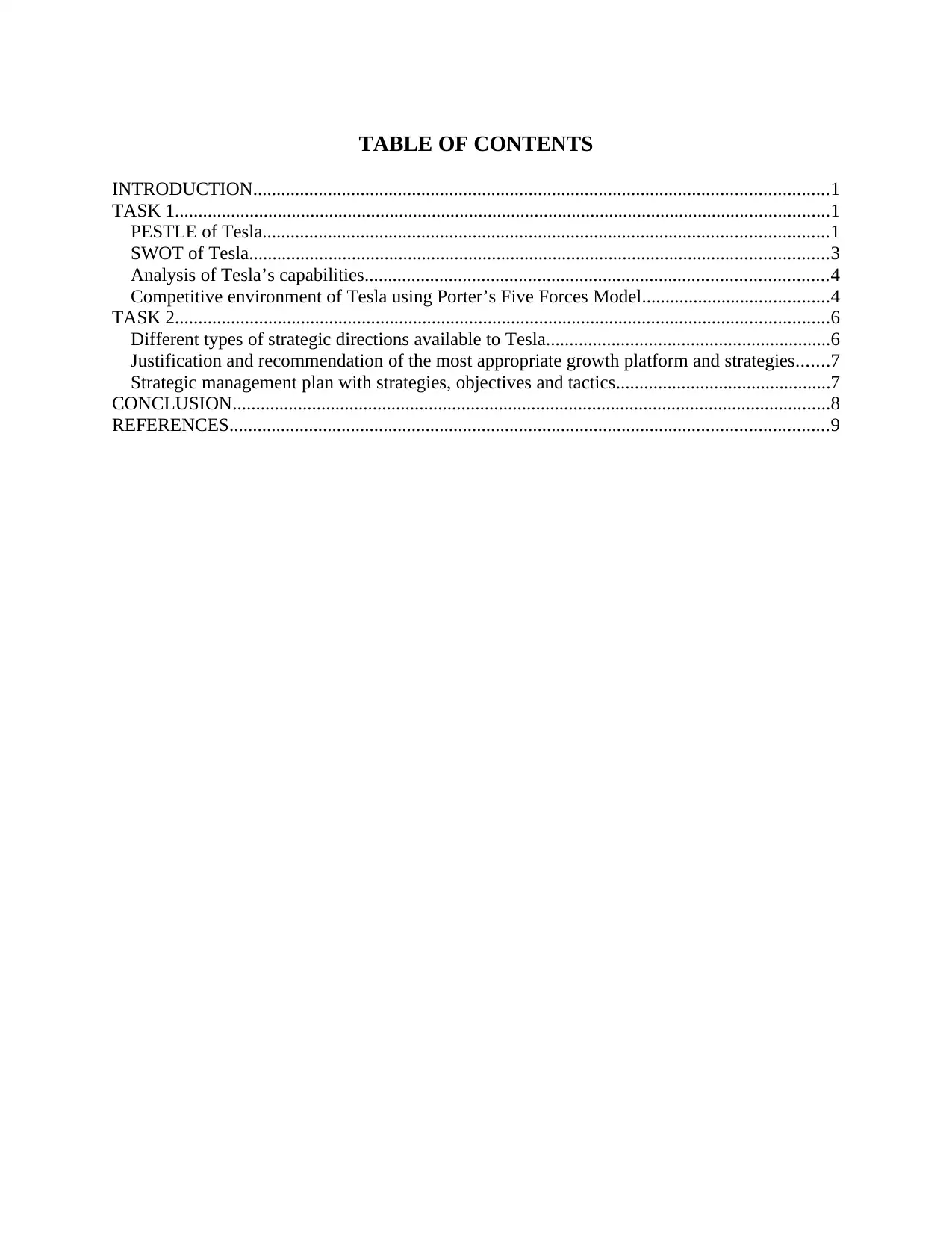
TABLE OF CONTENTS
INTRODUCTION...........................................................................................................................1
TASK 1............................................................................................................................................1
PESTLE of Tesla.........................................................................................................................1
SWOT of Tesla............................................................................................................................3
Analysis of Tesla’s capabilities...................................................................................................4
Competitive environment of Tesla using Porter’s Five Forces Model........................................4
TASK 2............................................................................................................................................6
Different types of strategic directions available to Tesla.............................................................6
Justification and recommendation of the most appropriate growth platform and strategies.......7
Strategic management plan with strategies, objectives and tactics..............................................7
CONCLUSION................................................................................................................................8
REFERENCES................................................................................................................................9
INTRODUCTION...........................................................................................................................1
TASK 1............................................................................................................................................1
PESTLE of Tesla.........................................................................................................................1
SWOT of Tesla............................................................................................................................3
Analysis of Tesla’s capabilities...................................................................................................4
Competitive environment of Tesla using Porter’s Five Forces Model........................................4
TASK 2............................................................................................................................................6
Different types of strategic directions available to Tesla.............................................................6
Justification and recommendation of the most appropriate growth platform and strategies.......7
Strategic management plan with strategies, objectives and tactics..............................................7
CONCLUSION................................................................................................................................8
REFERENCES................................................................................................................................9
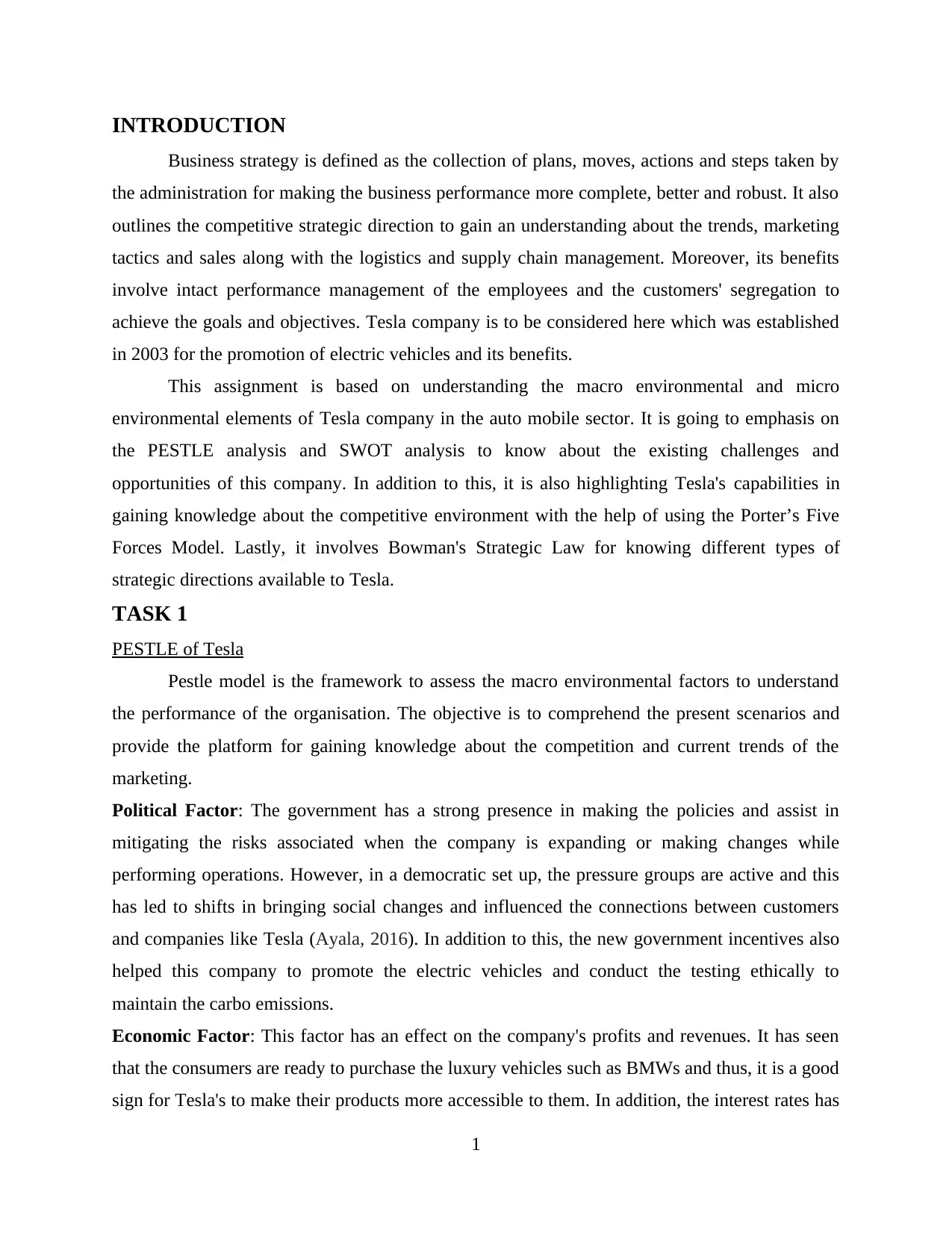
INTRODUCTION
Business strategy is defined as the collection of plans, moves, actions and steps taken by
the administration for making the business performance more complete, better and robust. It also
outlines the competitive strategic direction to gain an understanding about the trends, marketing
tactics and sales along with the logistics and supply chain management. Moreover, its benefits
involve intact performance management of the employees and the customers' segregation to
achieve the goals and objectives. Tesla company is to be considered here which was established
in 2003 for the promotion of electric vehicles and its benefits.
This assignment is based on understanding the macro environmental and micro
environmental elements of Tesla company in the auto mobile sector. It is going to emphasis on
the PESTLE analysis and SWOT analysis to know about the existing challenges and
opportunities of this company. In addition to this, it is also highlighting Tesla's capabilities in
gaining knowledge about the competitive environment with the help of using the Porter’s Five
Forces Model. Lastly, it involves Bowman's Strategic Law for knowing different types of
strategic directions available to Tesla.
TASK 1
PESTLE of Tesla
Pestle model is the framework to assess the macro environmental factors to understand
the performance of the organisation. The objective is to comprehend the present scenarios and
provide the platform for gaining knowledge about the competition and current trends of the
marketing.
Political Factor: The government has a strong presence in making the policies and assist in
mitigating the risks associated when the company is expanding or making changes while
performing operations. However, in a democratic set up, the pressure groups are active and this
has led to shifts in bringing social changes and influenced the connections between customers
and companies like Tesla (Ayala, 2016). In addition to this, the new government incentives also
helped this company to promote the electric vehicles and conduct the testing ethically to
maintain the carbo emissions.
Economic Factor: This factor has an effect on the company's profits and revenues. It has seen
that the consumers are ready to purchase the luxury vehicles such as BMWs and thus, it is a good
sign for Tesla's to make their products more accessible to them. In addition, the interest rates has
1
Business strategy is defined as the collection of plans, moves, actions and steps taken by
the administration for making the business performance more complete, better and robust. It also
outlines the competitive strategic direction to gain an understanding about the trends, marketing
tactics and sales along with the logistics and supply chain management. Moreover, its benefits
involve intact performance management of the employees and the customers' segregation to
achieve the goals and objectives. Tesla company is to be considered here which was established
in 2003 for the promotion of electric vehicles and its benefits.
This assignment is based on understanding the macro environmental and micro
environmental elements of Tesla company in the auto mobile sector. It is going to emphasis on
the PESTLE analysis and SWOT analysis to know about the existing challenges and
opportunities of this company. In addition to this, it is also highlighting Tesla's capabilities in
gaining knowledge about the competitive environment with the help of using the Porter’s Five
Forces Model. Lastly, it involves Bowman's Strategic Law for knowing different types of
strategic directions available to Tesla.
TASK 1
PESTLE of Tesla
Pestle model is the framework to assess the macro environmental factors to understand
the performance of the organisation. The objective is to comprehend the present scenarios and
provide the platform for gaining knowledge about the competition and current trends of the
marketing.
Political Factor: The government has a strong presence in making the policies and assist in
mitigating the risks associated when the company is expanding or making changes while
performing operations. However, in a democratic set up, the pressure groups are active and this
has led to shifts in bringing social changes and influenced the connections between customers
and companies like Tesla (Ayala, 2016). In addition to this, the new government incentives also
helped this company to promote the electric vehicles and conduct the testing ethically to
maintain the carbo emissions.
Economic Factor: This factor has an effect on the company's profits and revenues. It has seen
that the consumers are ready to purchase the luxury vehicles such as BMWs and thus, it is a good
sign for Tesla's to make their products more accessible to them. In addition, the interest rates has
1
⊘ This is a preview!⊘
Do you want full access?
Subscribe today to unlock all pages.

Trusted by 1+ million students worldwide
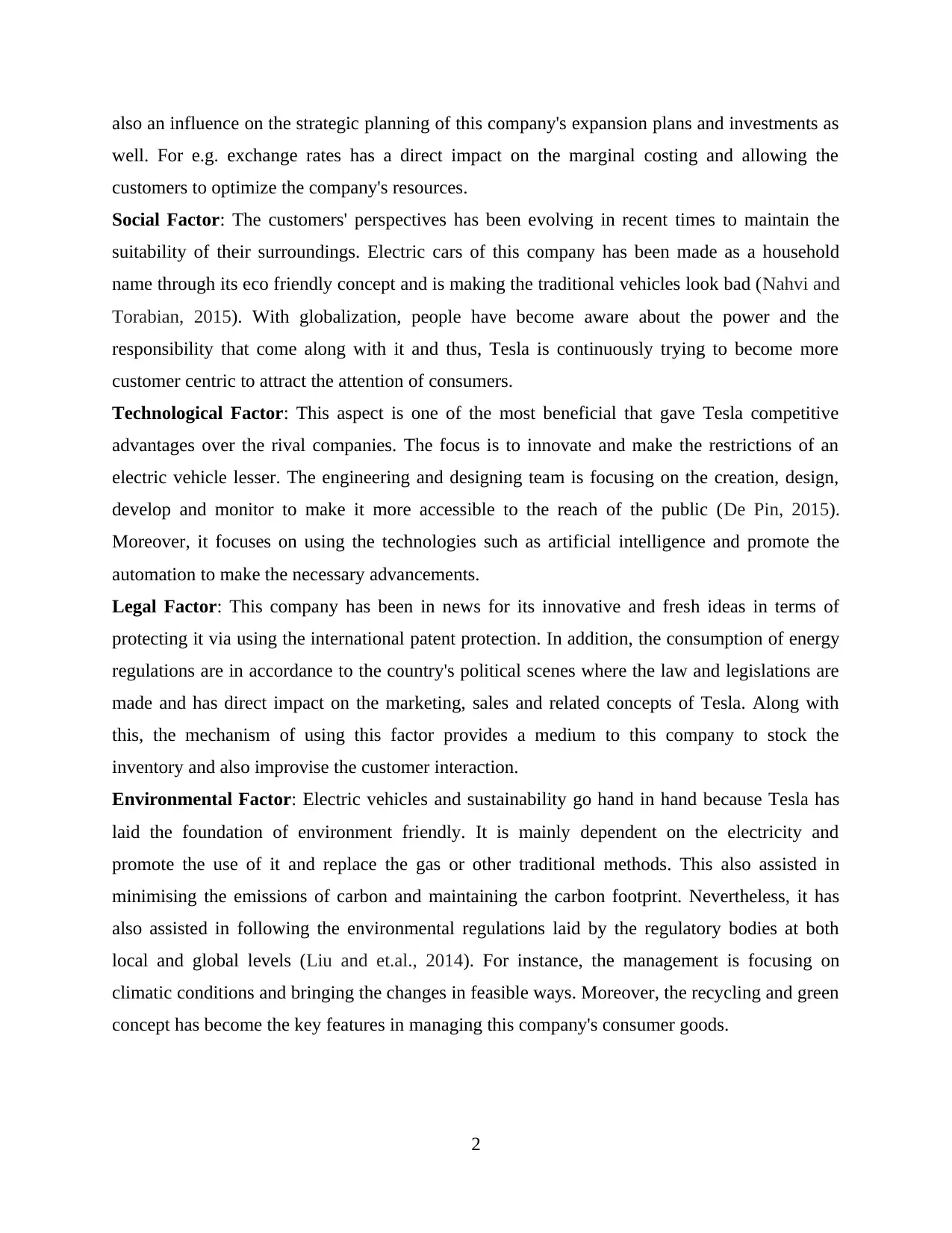
also an influence on the strategic planning of this company's expansion plans and investments as
well. For e.g. exchange rates has a direct impact on the marginal costing and allowing the
customers to optimize the company's resources.
Social Factor: The customers' perspectives has been evolving in recent times to maintain the
suitability of their surroundings. Electric cars of this company has been made as a household
name through its eco friendly concept and is making the traditional vehicles look bad (Nahvi and
Torabian, 2015). With globalization, people have become aware about the power and the
responsibility that come along with it and thus, Tesla is continuously trying to become more
customer centric to attract the attention of consumers.
Technological Factor: This aspect is one of the most beneficial that gave Tesla competitive
advantages over the rival companies. The focus is to innovate and make the restrictions of an
electric vehicle lesser. The engineering and designing team is focusing on the creation, design,
develop and monitor to make it more accessible to the reach of the public (De Pin, 2015).
Moreover, it focuses on using the technologies such as artificial intelligence and promote the
automation to make the necessary advancements.
Legal Factor: This company has been in news for its innovative and fresh ideas in terms of
protecting it via using the international patent protection. In addition, the consumption of energy
regulations are in accordance to the country's political scenes where the law and legislations are
made and has direct impact on the marketing, sales and related concepts of Tesla. Along with
this, the mechanism of using this factor provides a medium to this company to stock the
inventory and also improvise the customer interaction.
Environmental Factor: Electric vehicles and sustainability go hand in hand because Tesla has
laid the foundation of environment friendly. It is mainly dependent on the electricity and
promote the use of it and replace the gas or other traditional methods. This also assisted in
minimising the emissions of carbon and maintaining the carbon footprint. Nevertheless, it has
also assisted in following the environmental regulations laid by the regulatory bodies at both
local and global levels (Liu and et.al., 2014). For instance, the management is focusing on
climatic conditions and bringing the changes in feasible ways. Moreover, the recycling and green
concept has become the key features in managing this company's consumer goods.
2
well. For e.g. exchange rates has a direct impact on the marginal costing and allowing the
customers to optimize the company's resources.
Social Factor: The customers' perspectives has been evolving in recent times to maintain the
suitability of their surroundings. Electric cars of this company has been made as a household
name through its eco friendly concept and is making the traditional vehicles look bad (Nahvi and
Torabian, 2015). With globalization, people have become aware about the power and the
responsibility that come along with it and thus, Tesla is continuously trying to become more
customer centric to attract the attention of consumers.
Technological Factor: This aspect is one of the most beneficial that gave Tesla competitive
advantages over the rival companies. The focus is to innovate and make the restrictions of an
electric vehicle lesser. The engineering and designing team is focusing on the creation, design,
develop and monitor to make it more accessible to the reach of the public (De Pin, 2015).
Moreover, it focuses on using the technologies such as artificial intelligence and promote the
automation to make the necessary advancements.
Legal Factor: This company has been in news for its innovative and fresh ideas in terms of
protecting it via using the international patent protection. In addition, the consumption of energy
regulations are in accordance to the country's political scenes where the law and legislations are
made and has direct impact on the marketing, sales and related concepts of Tesla. Along with
this, the mechanism of using this factor provides a medium to this company to stock the
inventory and also improvise the customer interaction.
Environmental Factor: Electric vehicles and sustainability go hand in hand because Tesla has
laid the foundation of environment friendly. It is mainly dependent on the electricity and
promote the use of it and replace the gas or other traditional methods. This also assisted in
minimising the emissions of carbon and maintaining the carbon footprint. Nevertheless, it has
also assisted in following the environmental regulations laid by the regulatory bodies at both
local and global levels (Liu and et.al., 2014). For instance, the management is focusing on
climatic conditions and bringing the changes in feasible ways. Moreover, the recycling and green
concept has become the key features in managing this company's consumer goods.
2
Paraphrase This Document
Need a fresh take? Get an instant paraphrase of this document with our AI Paraphraser
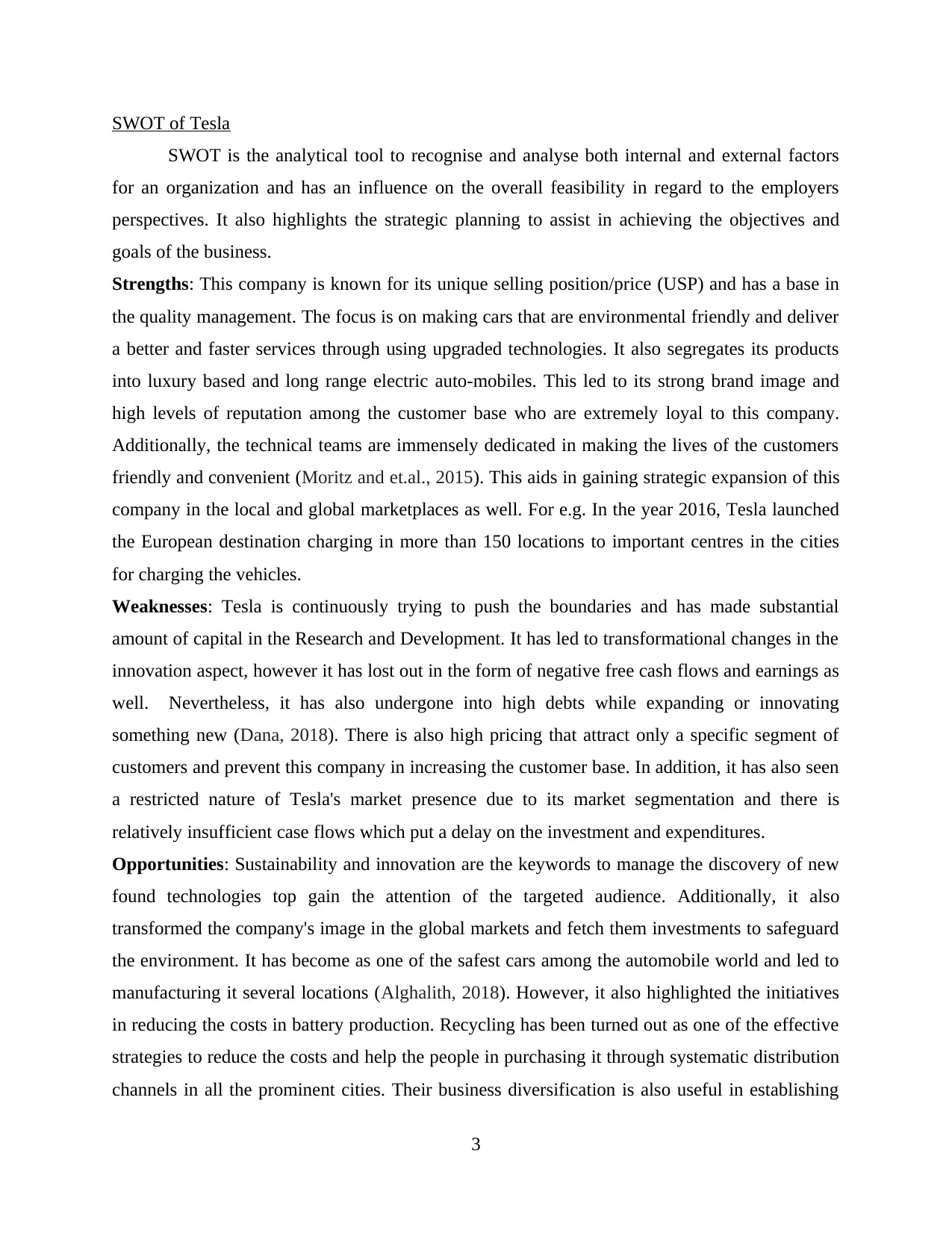
SWOT of Tesla
SWOT is the analytical tool to recognise and analyse both internal and external factors
for an organization and has an influence on the overall feasibility in regard to the employers
perspectives. It also highlights the strategic planning to assist in achieving the objectives and
goals of the business.
Strengths: This company is known for its unique selling position/price (USP) and has a base in
the quality management. The focus is on making cars that are environmental friendly and deliver
a better and faster services through using upgraded technologies. It also segregates its products
into luxury based and long range electric auto-mobiles. This led to its strong brand image and
high levels of reputation among the customer base who are extremely loyal to this company.
Additionally, the technical teams are immensely dedicated in making the lives of the customers
friendly and convenient (Moritz and et.al., 2015). This aids in gaining strategic expansion of this
company in the local and global marketplaces as well. For e.g. In the year 2016, Tesla launched
the European destination charging in more than 150 locations to important centres in the cities
for charging the vehicles.
Weaknesses: Tesla is continuously trying to push the boundaries and has made substantial
amount of capital in the Research and Development. It has led to transformational changes in the
innovation aspect, however it has lost out in the form of negative free cash flows and earnings as
well. Nevertheless, it has also undergone into high debts while expanding or innovating
something new (Dana, 2018). There is also high pricing that attract only a specific segment of
customers and prevent this company in increasing the customer base. In addition, it has also seen
a restricted nature of Tesla's market presence due to its market segmentation and there is
relatively insufficient case flows which put a delay on the investment and expenditures.
Opportunities: Sustainability and innovation are the keywords to manage the discovery of new
found technologies top gain the attention of the targeted audience. Additionally, it also
transformed the company's image in the global markets and fetch them investments to safeguard
the environment. It has become as one of the safest cars among the automobile world and led to
manufacturing it several locations (Alghalith, 2018). However, it also highlighted the initiatives
in reducing the costs in battery production. Recycling has been turned out as one of the effective
strategies to reduce the costs and help the people in purchasing it through systematic distribution
channels in all the prominent cities. Their business diversification is also useful in establishing
3
SWOT is the analytical tool to recognise and analyse both internal and external factors
for an organization and has an influence on the overall feasibility in regard to the employers
perspectives. It also highlights the strategic planning to assist in achieving the objectives and
goals of the business.
Strengths: This company is known for its unique selling position/price (USP) and has a base in
the quality management. The focus is on making cars that are environmental friendly and deliver
a better and faster services through using upgraded technologies. It also segregates its products
into luxury based and long range electric auto-mobiles. This led to its strong brand image and
high levels of reputation among the customer base who are extremely loyal to this company.
Additionally, the technical teams are immensely dedicated in making the lives of the customers
friendly and convenient (Moritz and et.al., 2015). This aids in gaining strategic expansion of this
company in the local and global marketplaces as well. For e.g. In the year 2016, Tesla launched
the European destination charging in more than 150 locations to important centres in the cities
for charging the vehicles.
Weaknesses: Tesla is continuously trying to push the boundaries and has made substantial
amount of capital in the Research and Development. It has led to transformational changes in the
innovation aspect, however it has lost out in the form of negative free cash flows and earnings as
well. Nevertheless, it has also undergone into high debts while expanding or innovating
something new (Dana, 2018). There is also high pricing that attract only a specific segment of
customers and prevent this company in increasing the customer base. In addition, it has also seen
a restricted nature of Tesla's market presence due to its market segmentation and there is
relatively insufficient case flows which put a delay on the investment and expenditures.
Opportunities: Sustainability and innovation are the keywords to manage the discovery of new
found technologies top gain the attention of the targeted audience. Additionally, it also
transformed the company's image in the global markets and fetch them investments to safeguard
the environment. It has become as one of the safest cars among the automobile world and led to
manufacturing it several locations (Alghalith, 2018). However, it also highlighted the initiatives
in reducing the costs in battery production. Recycling has been turned out as one of the effective
strategies to reduce the costs and help the people in purchasing it through systematic distribution
channels in all the prominent cities. Their business diversification is also useful in establishing
3
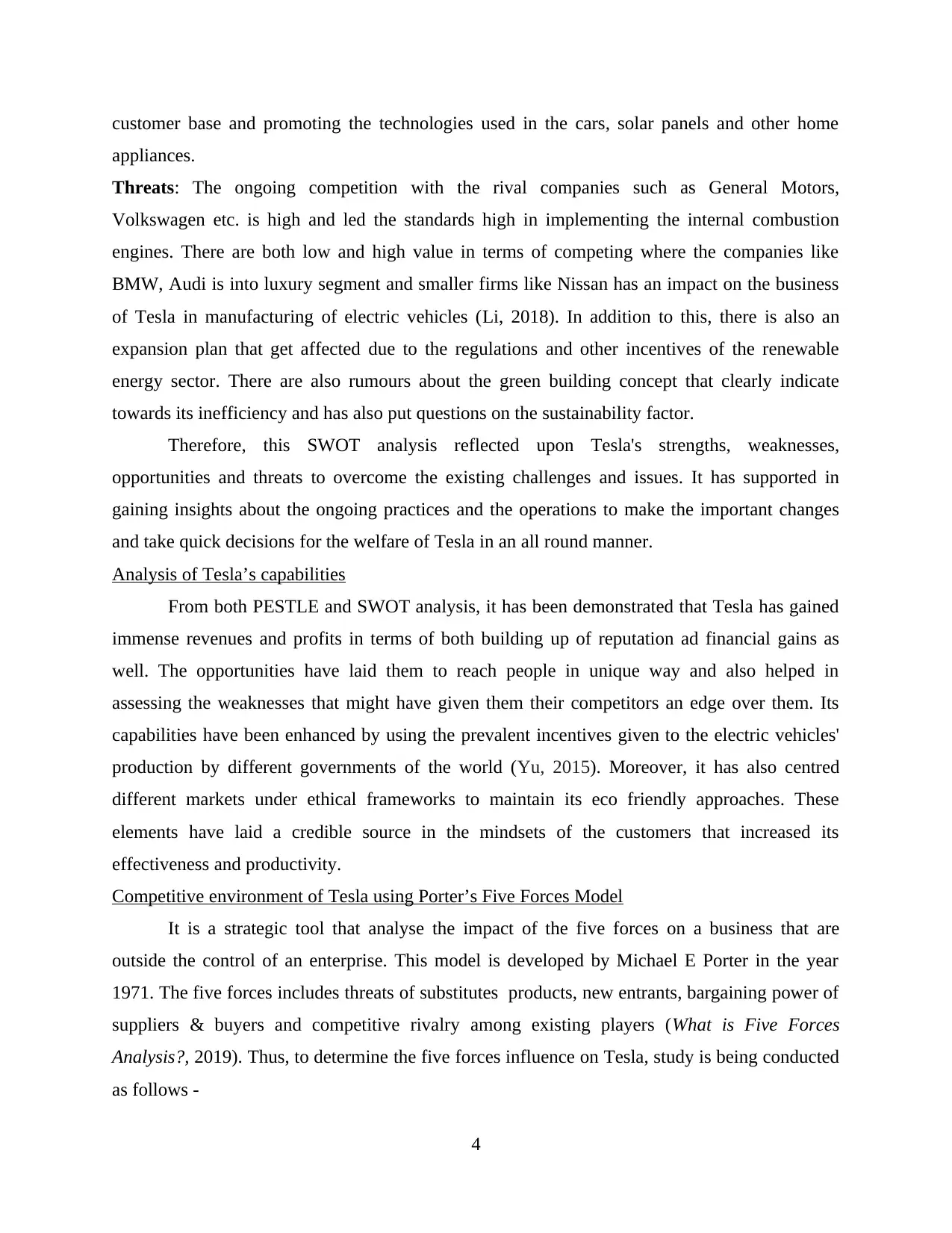
customer base and promoting the technologies used in the cars, solar panels and other home
appliances.
Threats: The ongoing competition with the rival companies such as General Motors,
Volkswagen etc. is high and led the standards high in implementing the internal combustion
engines. There are both low and high value in terms of competing where the companies like
BMW, Audi is into luxury segment and smaller firms like Nissan has an impact on the business
of Tesla in manufacturing of electric vehicles (Li, 2018). In addition to this, there is also an
expansion plan that get affected due to the regulations and other incentives of the renewable
energy sector. There are also rumours about the green building concept that clearly indicate
towards its inefficiency and has also put questions on the sustainability factor.
Therefore, this SWOT analysis reflected upon Tesla's strengths, weaknesses,
opportunities and threats to overcome the existing challenges and issues. It has supported in
gaining insights about the ongoing practices and the operations to make the important changes
and take quick decisions for the welfare of Tesla in an all round manner.
Analysis of Tesla’s capabilities
From both PESTLE and SWOT analysis, it has been demonstrated that Tesla has gained
immense revenues and profits in terms of both building up of reputation ad financial gains as
well. The opportunities have laid them to reach people in unique way and also helped in
assessing the weaknesses that might have given them their competitors an edge over them. Its
capabilities have been enhanced by using the prevalent incentives given to the electric vehicles'
production by different governments of the world (Yu, 2015). Moreover, it has also centred
different markets under ethical frameworks to maintain its eco friendly approaches. These
elements have laid a credible source in the mindsets of the customers that increased its
effectiveness and productivity.
Competitive environment of Tesla using Porter’s Five Forces Model
It is a strategic tool that analyse the impact of the five forces on a business that are
outside the control of an enterprise. This model is developed by Michael E Porter in the year
1971. The five forces includes threats of substitutes products, new entrants, bargaining power of
suppliers & buyers and competitive rivalry among existing players (What is Five Forces
Analysis?, 2019). Thus, to determine the five forces influence on Tesla, study is being conducted
as follows -
4
appliances.
Threats: The ongoing competition with the rival companies such as General Motors,
Volkswagen etc. is high and led the standards high in implementing the internal combustion
engines. There are both low and high value in terms of competing where the companies like
BMW, Audi is into luxury segment and smaller firms like Nissan has an impact on the business
of Tesla in manufacturing of electric vehicles (Li, 2018). In addition to this, there is also an
expansion plan that get affected due to the regulations and other incentives of the renewable
energy sector. There are also rumours about the green building concept that clearly indicate
towards its inefficiency and has also put questions on the sustainability factor.
Therefore, this SWOT analysis reflected upon Tesla's strengths, weaknesses,
opportunities and threats to overcome the existing challenges and issues. It has supported in
gaining insights about the ongoing practices and the operations to make the important changes
and take quick decisions for the welfare of Tesla in an all round manner.
Analysis of Tesla’s capabilities
From both PESTLE and SWOT analysis, it has been demonstrated that Tesla has gained
immense revenues and profits in terms of both building up of reputation ad financial gains as
well. The opportunities have laid them to reach people in unique way and also helped in
assessing the weaknesses that might have given them their competitors an edge over them. Its
capabilities have been enhanced by using the prevalent incentives given to the electric vehicles'
production by different governments of the world (Yu, 2015). Moreover, it has also centred
different markets under ethical frameworks to maintain its eco friendly approaches. These
elements have laid a credible source in the mindsets of the customers that increased its
effectiveness and productivity.
Competitive environment of Tesla using Porter’s Five Forces Model
It is a strategic tool that analyse the impact of the five forces on a business that are
outside the control of an enterprise. This model is developed by Michael E Porter in the year
1971. The five forces includes threats of substitutes products, new entrants, bargaining power of
suppliers & buyers and competitive rivalry among existing players (What is Five Forces
Analysis?, 2019). Thus, to determine the five forces influence on Tesla, study is being conducted
as follows -
4
⊘ This is a preview!⊘
Do you want full access?
Subscribe today to unlock all pages.

Trusted by 1+ million students worldwide
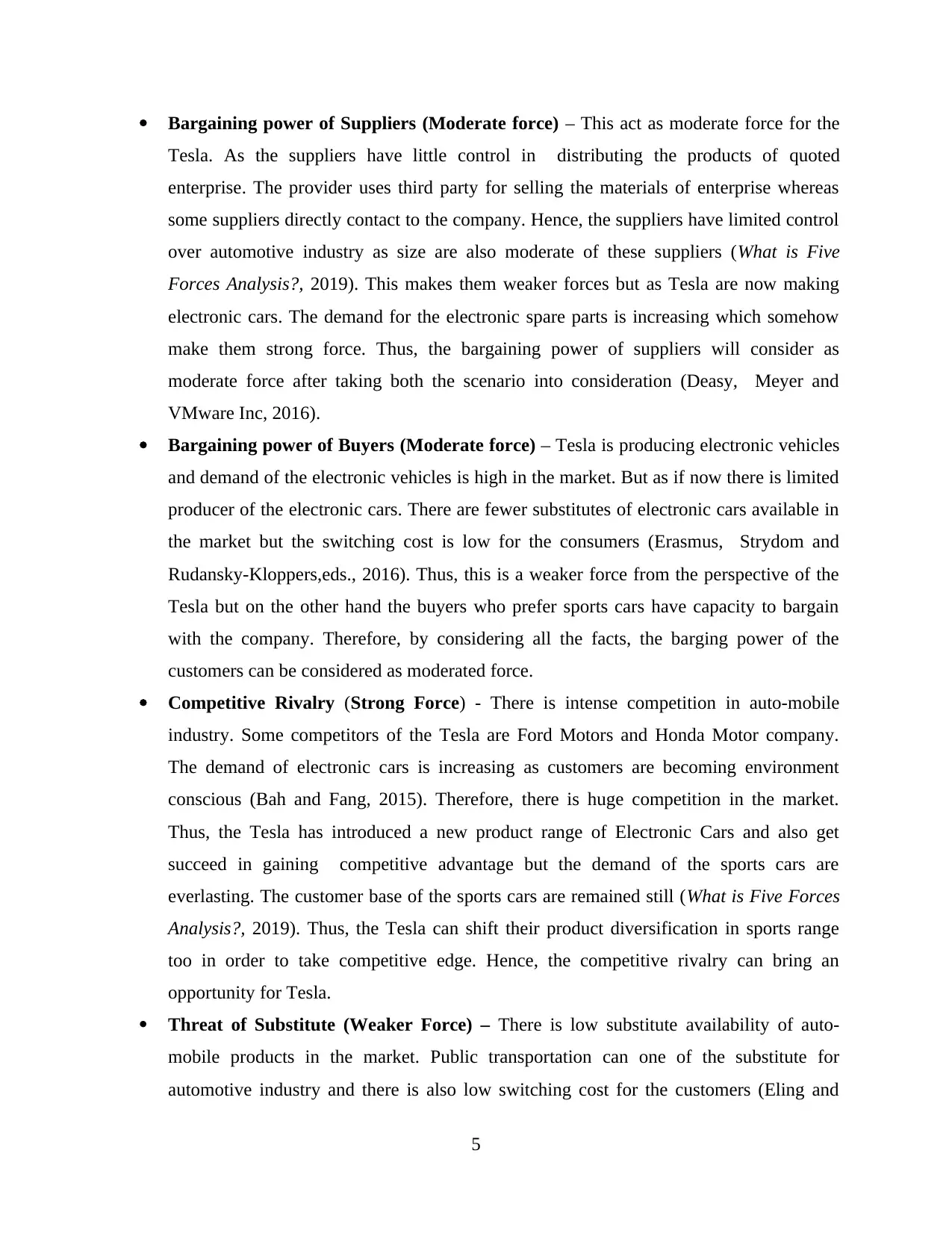
Bargaining power of Suppliers (Moderate force) – This act as moderate force for the
Tesla. As the suppliers have little control in distributing the products of quoted
enterprise. The provider uses third party for selling the materials of enterprise whereas
some suppliers directly contact to the company. Hence, the suppliers have limited control
over automotive industry as size are also moderate of these suppliers (What is Five
Forces Analysis?, 2019). This makes them weaker forces but as Tesla are now making
electronic cars. The demand for the electronic spare parts is increasing which somehow
make them strong force. Thus, the bargaining power of suppliers will consider as
moderate force after taking both the scenario into consideration (Deasy, Meyer and
VMware Inc, 2016).
Bargaining power of Buyers (Moderate force) – Tesla is producing electronic vehicles
and demand of the electronic vehicles is high in the market. But as if now there is limited
producer of the electronic cars. There are fewer substitutes of electronic cars available in
the market but the switching cost is low for the consumers (Erasmus, Strydom and
Rudansky-Kloppers,eds., 2016). Thus, this is a weaker force from the perspective of the
Tesla but on the other hand the buyers who prefer sports cars have capacity to bargain
with the company. Therefore, by considering all the facts, the barging power of the
customers can be considered as moderated force.
Competitive Rivalry (Strong Force) - There is intense competition in auto-mobile
industry. Some competitors of the Tesla are Ford Motors and Honda Motor company.
The demand of electronic cars is increasing as customers are becoming environment
conscious (Bah and Fang, 2015). Therefore, there is huge competition in the market.
Thus, the Tesla has introduced a new product range of Electronic Cars and also get
succeed in gaining competitive advantage but the demand of the sports cars are
everlasting. The customer base of the sports cars are remained still (What is Five Forces
Analysis?, 2019). Thus, the Tesla can shift their product diversification in sports range
too in order to take competitive edge. Hence, the competitive rivalry can bring an
opportunity for Tesla.
Threat of Substitute (Weaker Force) – There is low substitute availability of auto-
mobile products in the market. Public transportation can one of the substitute for
automotive industry and there is also low switching cost for the customers (Eling and
5
Tesla. As the suppliers have little control in distributing the products of quoted
enterprise. The provider uses third party for selling the materials of enterprise whereas
some suppliers directly contact to the company. Hence, the suppliers have limited control
over automotive industry as size are also moderate of these suppliers (What is Five
Forces Analysis?, 2019). This makes them weaker forces but as Tesla are now making
electronic cars. The demand for the electronic spare parts is increasing which somehow
make them strong force. Thus, the bargaining power of suppliers will consider as
moderate force after taking both the scenario into consideration (Deasy, Meyer and
VMware Inc, 2016).
Bargaining power of Buyers (Moderate force) – Tesla is producing electronic vehicles
and demand of the electronic vehicles is high in the market. But as if now there is limited
producer of the electronic cars. There are fewer substitutes of electronic cars available in
the market but the switching cost is low for the consumers (Erasmus, Strydom and
Rudansky-Kloppers,eds., 2016). Thus, this is a weaker force from the perspective of the
Tesla but on the other hand the buyers who prefer sports cars have capacity to bargain
with the company. Therefore, by considering all the facts, the barging power of the
customers can be considered as moderated force.
Competitive Rivalry (Strong Force) - There is intense competition in auto-mobile
industry. Some competitors of the Tesla are Ford Motors and Honda Motor company.
The demand of electronic cars is increasing as customers are becoming environment
conscious (Bah and Fang, 2015). Therefore, there is huge competition in the market.
Thus, the Tesla has introduced a new product range of Electronic Cars and also get
succeed in gaining competitive advantage but the demand of the sports cars are
everlasting. The customer base of the sports cars are remained still (What is Five Forces
Analysis?, 2019). Thus, the Tesla can shift their product diversification in sports range
too in order to take competitive edge. Hence, the competitive rivalry can bring an
opportunity for Tesla.
Threat of Substitute (Weaker Force) – There is low substitute availability of auto-
mobile products in the market. Public transportation can one of the substitute for
automotive industry and there is also low switching cost for the customers (Eling and
5
Paraphrase This Document
Need a fresh take? Get an instant paraphrase of this document with our AI Paraphraser
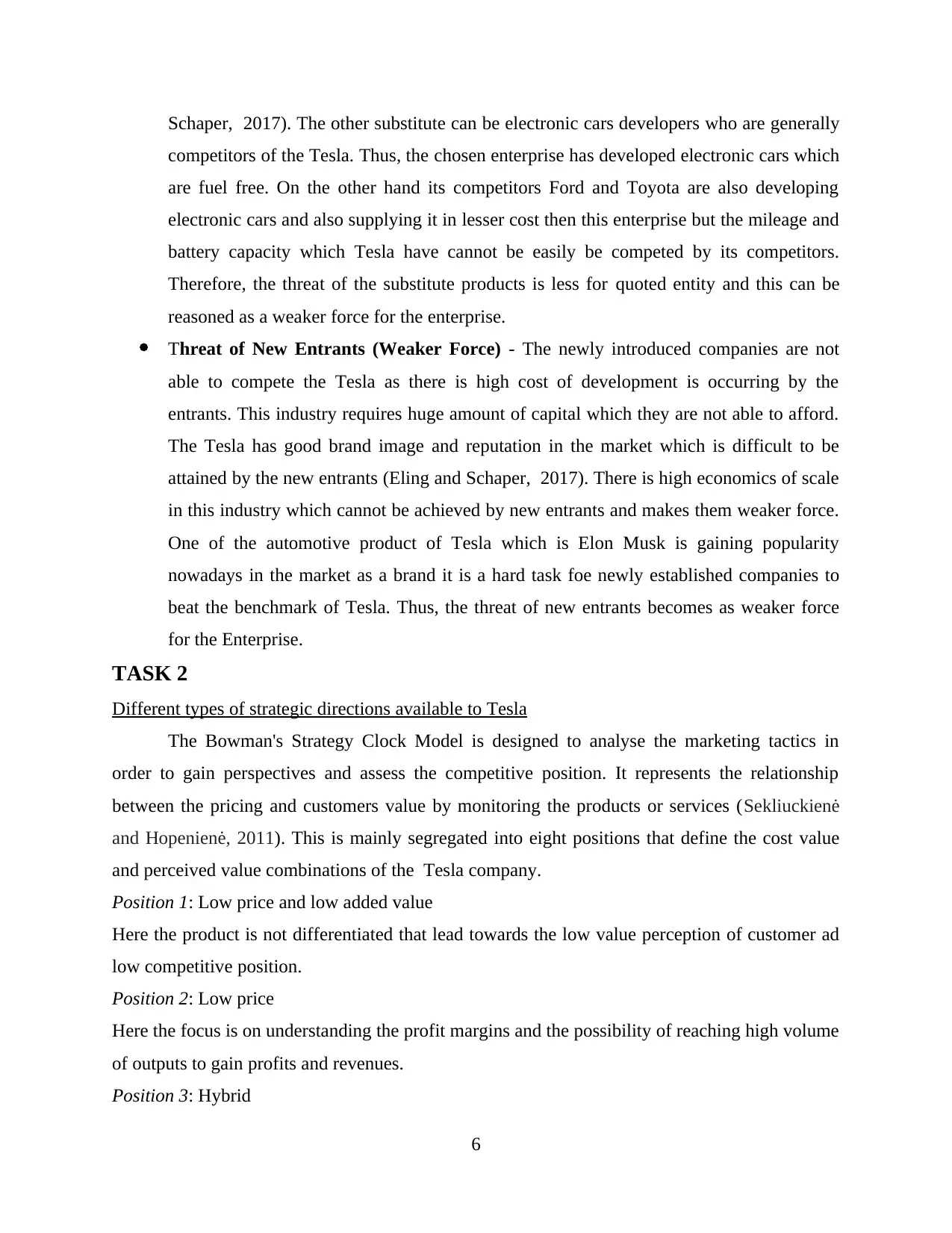
Schaper, 2017). The other substitute can be electronic cars developers who are generally
competitors of the Tesla. Thus, the chosen enterprise has developed electronic cars which
are fuel free. On the other hand its competitors Ford and Toyota are also developing
electronic cars and also supplying it in lesser cost then this enterprise but the mileage and
battery capacity which Tesla have cannot be easily be competed by its competitors.
Therefore, the threat of the substitute products is less for quoted entity and this can be
reasoned as a weaker force for the enterprise.
Threat of New Entrants (Weaker Force) - The newly introduced companies are not
able to compete the Tesla as there is high cost of development is occurring by the
entrants. This industry requires huge amount of capital which they are not able to afford.
The Tesla has good brand image and reputation in the market which is difficult to be
attained by the new entrants (Eling and Schaper, 2017). There is high economics of scale
in this industry which cannot be achieved by new entrants and makes them weaker force.
One of the automotive product of Tesla which is Elon Musk is gaining popularity
nowadays in the market as a brand it is a hard task foe newly established companies to
beat the benchmark of Tesla. Thus, the threat of new entrants becomes as weaker force
for the Enterprise.
TASK 2
Different types of strategic directions available to Tesla
The Bowman's Strategy Clock Model is designed to analyse the marketing tactics in
order to gain perspectives and assess the competitive position. It represents the relationship
between the pricing and customers value by monitoring the products or services (Sekliuckienė
and Hopenienė, 2011). This is mainly segregated into eight positions that define the cost value
and perceived value combinations of the Tesla company.
Position 1: Low price and low added value
Here the product is not differentiated that lead towards the low value perception of customer ad
low competitive position.
Position 2: Low price
Here the focus is on understanding the profit margins and the possibility of reaching high volume
of outputs to gain profits and revenues.
Position 3: Hybrid
6
competitors of the Tesla. Thus, the chosen enterprise has developed electronic cars which
are fuel free. On the other hand its competitors Ford and Toyota are also developing
electronic cars and also supplying it in lesser cost then this enterprise but the mileage and
battery capacity which Tesla have cannot be easily be competed by its competitors.
Therefore, the threat of the substitute products is less for quoted entity and this can be
reasoned as a weaker force for the enterprise.
Threat of New Entrants (Weaker Force) - The newly introduced companies are not
able to compete the Tesla as there is high cost of development is occurring by the
entrants. This industry requires huge amount of capital which they are not able to afford.
The Tesla has good brand image and reputation in the market which is difficult to be
attained by the new entrants (Eling and Schaper, 2017). There is high economics of scale
in this industry which cannot be achieved by new entrants and makes them weaker force.
One of the automotive product of Tesla which is Elon Musk is gaining popularity
nowadays in the market as a brand it is a hard task foe newly established companies to
beat the benchmark of Tesla. Thus, the threat of new entrants becomes as weaker force
for the Enterprise.
TASK 2
Different types of strategic directions available to Tesla
The Bowman's Strategy Clock Model is designed to analyse the marketing tactics in
order to gain perspectives and assess the competitive position. It represents the relationship
between the pricing and customers value by monitoring the products or services (Sekliuckienė
and Hopenienė, 2011). This is mainly segregated into eight positions that define the cost value
and perceived value combinations of the Tesla company.
Position 1: Low price and low added value
Here the product is not differentiated that lead towards the low value perception of customer ad
low competitive position.
Position 2: Low price
Here the focus is on understanding the profit margins and the possibility of reaching high volume
of outputs to gain profits and revenues.
Position 3: Hybrid
6
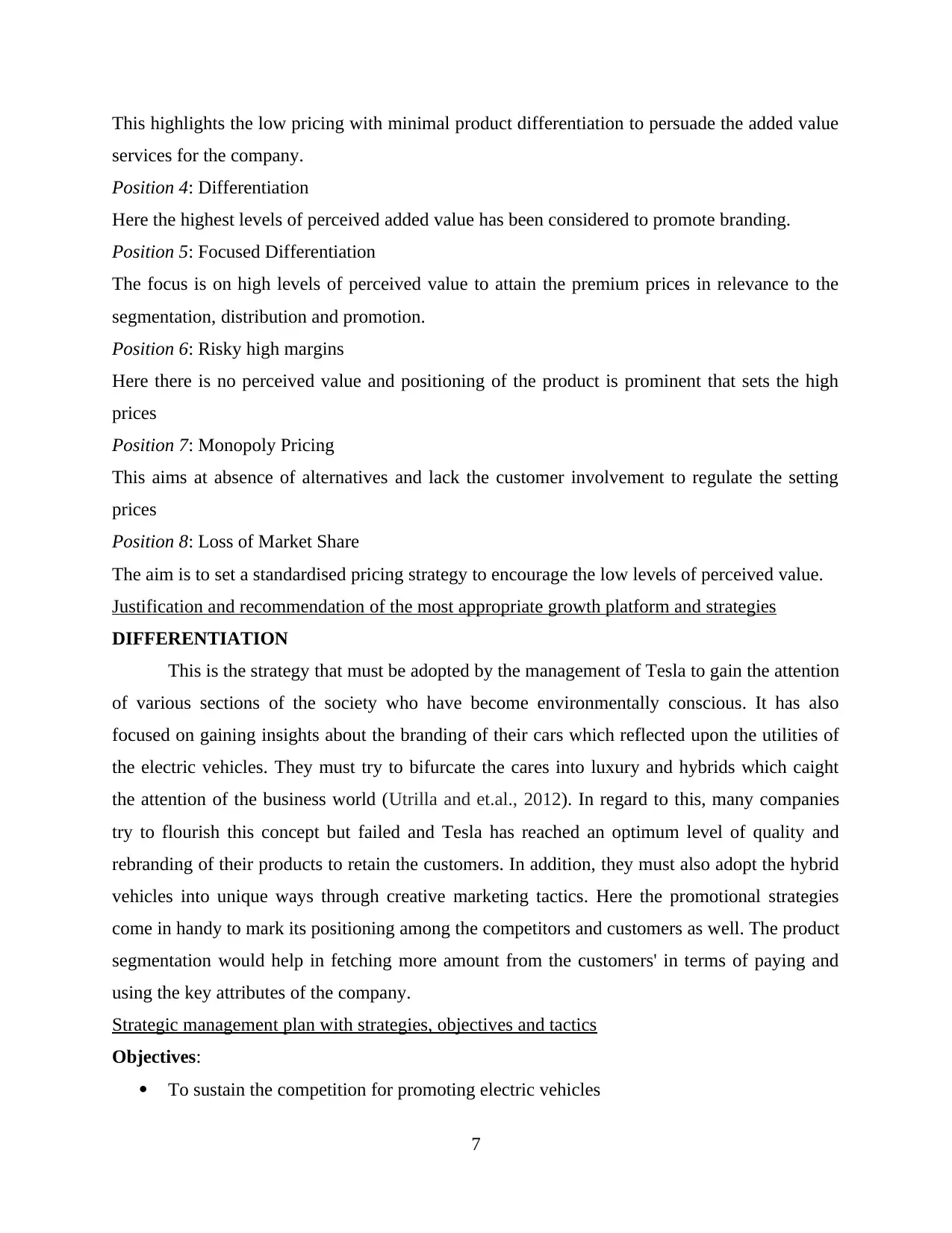
This highlights the low pricing with minimal product differentiation to persuade the added value
services for the company.
Position 4: Differentiation
Here the highest levels of perceived added value has been considered to promote branding.
Position 5: Focused Differentiation
The focus is on high levels of perceived value to attain the premium prices in relevance to the
segmentation, distribution and promotion.
Position 6: Risky high margins
Here there is no perceived value and positioning of the product is prominent that sets the high
prices
Position 7: Monopoly Pricing
This aims at absence of alternatives and lack the customer involvement to regulate the setting
prices
Position 8: Loss of Market Share
The aim is to set a standardised pricing strategy to encourage the low levels of perceived value.
Justification and recommendation of the most appropriate growth platform and strategies
DIFFERENTIATION
This is the strategy that must be adopted by the management of Tesla to gain the attention
of various sections of the society who have become environmentally conscious. It has also
focused on gaining insights about the branding of their cars which reflected upon the utilities of
the electric vehicles. They must try to bifurcate the cares into luxury and hybrids which caight
the attention of the business world (Utrilla and et.al., 2012). In regard to this, many companies
try to flourish this concept but failed and Tesla has reached an optimum level of quality and
rebranding of their products to retain the customers. In addition, they must also adopt the hybrid
vehicles into unique ways through creative marketing tactics. Here the promotional strategies
come in handy to mark its positioning among the competitors and customers as well. The product
segmentation would help in fetching more amount from the customers' in terms of paying and
using the key attributes of the company.
Strategic management plan with strategies, objectives and tactics
Objectives:
To sustain the competition for promoting electric vehicles
7
services for the company.
Position 4: Differentiation
Here the highest levels of perceived added value has been considered to promote branding.
Position 5: Focused Differentiation
The focus is on high levels of perceived value to attain the premium prices in relevance to the
segmentation, distribution and promotion.
Position 6: Risky high margins
Here there is no perceived value and positioning of the product is prominent that sets the high
prices
Position 7: Monopoly Pricing
This aims at absence of alternatives and lack the customer involvement to regulate the setting
prices
Position 8: Loss of Market Share
The aim is to set a standardised pricing strategy to encourage the low levels of perceived value.
Justification and recommendation of the most appropriate growth platform and strategies
DIFFERENTIATION
This is the strategy that must be adopted by the management of Tesla to gain the attention
of various sections of the society who have become environmentally conscious. It has also
focused on gaining insights about the branding of their cars which reflected upon the utilities of
the electric vehicles. They must try to bifurcate the cares into luxury and hybrids which caight
the attention of the business world (Utrilla and et.al., 2012). In regard to this, many companies
try to flourish this concept but failed and Tesla has reached an optimum level of quality and
rebranding of their products to retain the customers. In addition, they must also adopt the hybrid
vehicles into unique ways through creative marketing tactics. Here the promotional strategies
come in handy to mark its positioning among the competitors and customers as well. The product
segmentation would help in fetching more amount from the customers' in terms of paying and
using the key attributes of the company.
Strategic management plan with strategies, objectives and tactics
Objectives:
To sustain the competition for promoting electric vehicles
7
⊘ This is a preview!⊘
Do you want full access?
Subscribe today to unlock all pages.

Trusted by 1+ million students worldwide
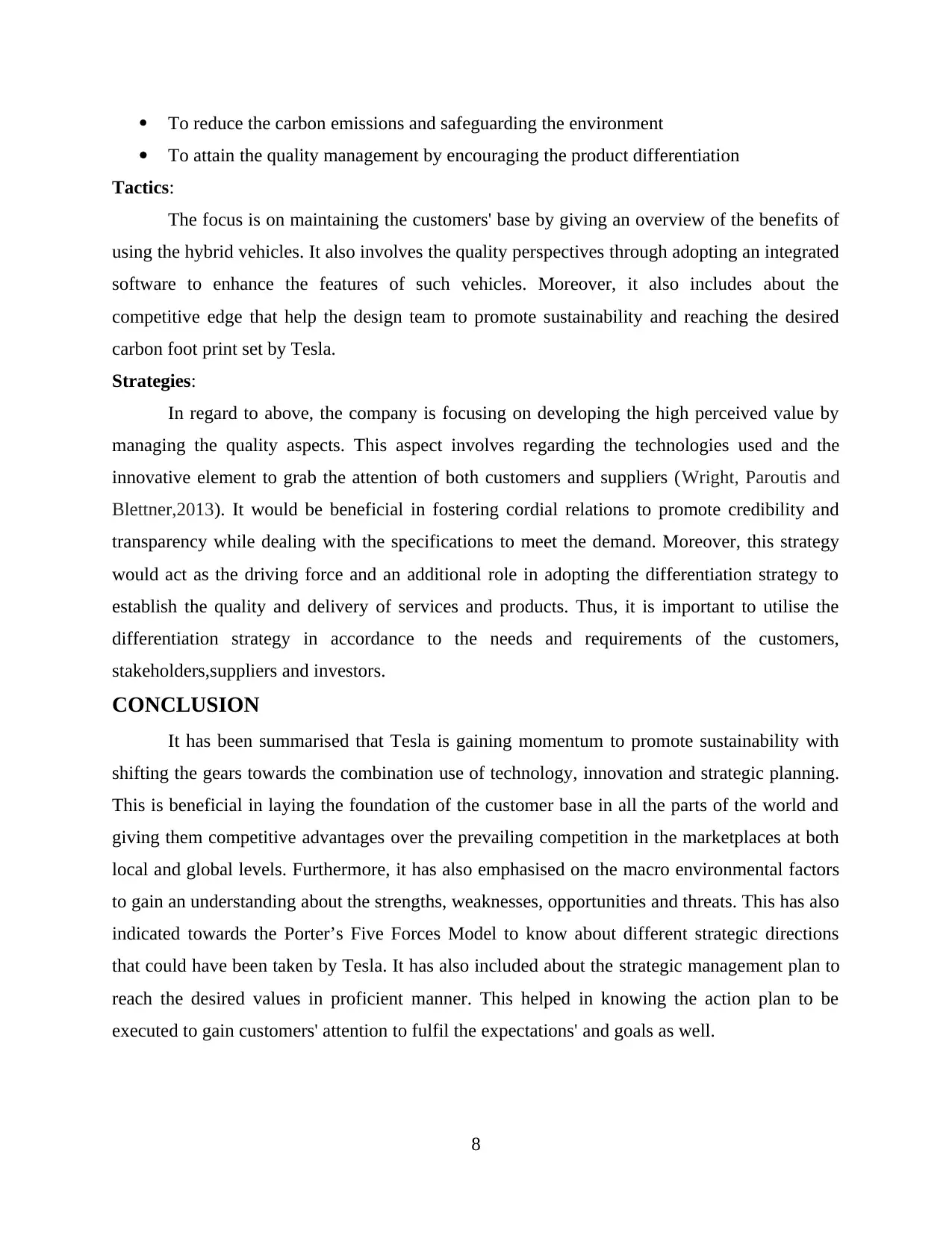
To reduce the carbon emissions and safeguarding the environment
To attain the quality management by encouraging the product differentiation
Tactics:
The focus is on maintaining the customers' base by giving an overview of the benefits of
using the hybrid vehicles. It also involves the quality perspectives through adopting an integrated
software to enhance the features of such vehicles. Moreover, it also includes about the
competitive edge that help the design team to promote sustainability and reaching the desired
carbon foot print set by Tesla.
Strategies:
In regard to above, the company is focusing on developing the high perceived value by
managing the quality aspects. This aspect involves regarding the technologies used and the
innovative element to grab the attention of both customers and suppliers (Wright, Paroutis and
Blettner,2013). It would be beneficial in fostering cordial relations to promote credibility and
transparency while dealing with the specifications to meet the demand. Moreover, this strategy
would act as the driving force and an additional role in adopting the differentiation strategy to
establish the quality and delivery of services and products. Thus, it is important to utilise the
differentiation strategy in accordance to the needs and requirements of the customers,
stakeholders,suppliers and investors.
CONCLUSION
It has been summarised that Tesla is gaining momentum to promote sustainability with
shifting the gears towards the combination use of technology, innovation and strategic planning.
This is beneficial in laying the foundation of the customer base in all the parts of the world and
giving them competitive advantages over the prevailing competition in the marketplaces at both
local and global levels. Furthermore, it has also emphasised on the macro environmental factors
to gain an understanding about the strengths, weaknesses, opportunities and threats. This has also
indicated towards the Porter’s Five Forces Model to know about different strategic directions
that could have been taken by Tesla. It has also included about the strategic management plan to
reach the desired values in proficient manner. This helped in knowing the action plan to be
executed to gain customers' attention to fulfil the expectations' and goals as well.
8
To attain the quality management by encouraging the product differentiation
Tactics:
The focus is on maintaining the customers' base by giving an overview of the benefits of
using the hybrid vehicles. It also involves the quality perspectives through adopting an integrated
software to enhance the features of such vehicles. Moreover, it also includes about the
competitive edge that help the design team to promote sustainability and reaching the desired
carbon foot print set by Tesla.
Strategies:
In regard to above, the company is focusing on developing the high perceived value by
managing the quality aspects. This aspect involves regarding the technologies used and the
innovative element to grab the attention of both customers and suppliers (Wright, Paroutis and
Blettner,2013). It would be beneficial in fostering cordial relations to promote credibility and
transparency while dealing with the specifications to meet the demand. Moreover, this strategy
would act as the driving force and an additional role in adopting the differentiation strategy to
establish the quality and delivery of services and products. Thus, it is important to utilise the
differentiation strategy in accordance to the needs and requirements of the customers,
stakeholders,suppliers and investors.
CONCLUSION
It has been summarised that Tesla is gaining momentum to promote sustainability with
shifting the gears towards the combination use of technology, innovation and strategic planning.
This is beneficial in laying the foundation of the customer base in all the parts of the world and
giving them competitive advantages over the prevailing competition in the marketplaces at both
local and global levels. Furthermore, it has also emphasised on the macro environmental factors
to gain an understanding about the strengths, weaknesses, opportunities and threats. This has also
indicated towards the Porter’s Five Forces Model to know about different strategic directions
that could have been taken by Tesla. It has also included about the strategic management plan to
reach the desired values in proficient manner. This helped in knowing the action plan to be
executed to gain customers' attention to fulfil the expectations' and goals as well.
8
Paraphrase This Document
Need a fresh take? Get an instant paraphrase of this document with our AI Paraphraser
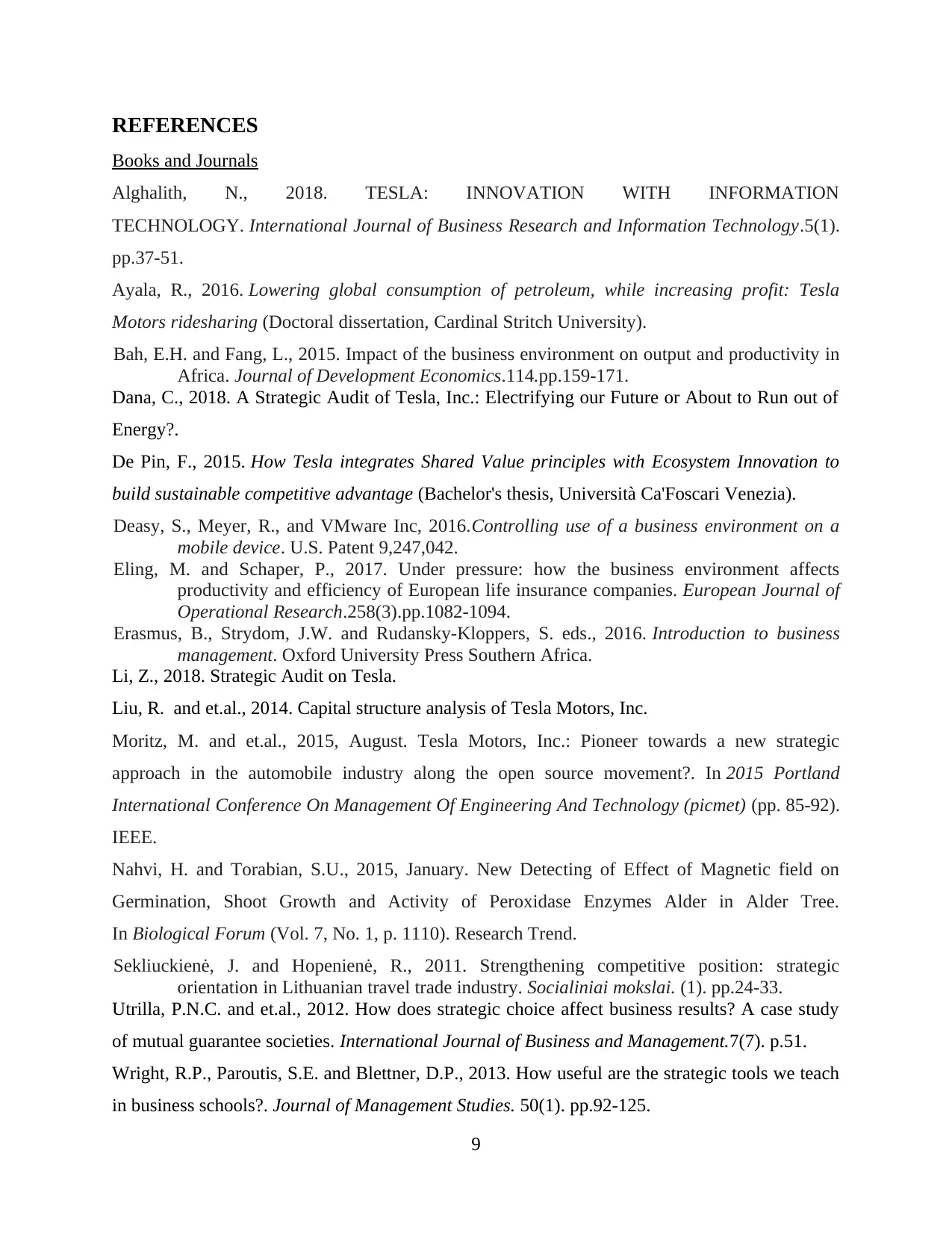
REFERENCES
Books and Journals
Alghalith, N., 2018. TESLA: INNOVATION WITH INFORMATION
TECHNOLOGY. International Journal of Business Research and Information Technology.5(1).
pp.37-51.
Ayala, R., 2016. Lowering global consumption of petroleum, while increasing profit: Tesla
Motors ridesharing (Doctoral dissertation, Cardinal Stritch University).
Bah, E.H. and Fang, L., 2015. Impact of the business environment on output and productivity in
Africa. Journal of Development Economics.114.pp.159-171.
Dana, C., 2018. A Strategic Audit of Tesla, Inc.: Electrifying our Future or About to Run out of
Energy?.
De Pin, F., 2015. How Tesla integrates Shared Value principles with Ecosystem Innovation to
build sustainable competitive advantage (Bachelor's thesis, Università Ca'Foscari Venezia).
Deasy, S., Meyer, R., and VMware Inc, 2016.Controlling use of a business environment on a
mobile device. U.S. Patent 9,247,042.
Eling, M. and Schaper, P., 2017. Under pressure: how the business environment affects
productivity and efficiency of European life insurance companies. European Journal of
Operational Research.258(3).pp.1082-1094.
Erasmus, B., Strydom, J.W. and Rudansky-Kloppers, S. eds., 2016. Introduction to business
management. Oxford University Press Southern Africa.
Li, Z., 2018. Strategic Audit on Tesla.
Liu, R. and et.al., 2014. Capital structure analysis of Tesla Motors, Inc.
Moritz, M. and et.al., 2015, August. Tesla Motors, Inc.: Pioneer towards a new strategic
approach in the automobile industry along the open source movement?. In 2015 Portland
International Conference On Management Of Engineering And Technology (picmet) (pp. 85-92).
IEEE.
Nahvi, H. and Torabian, S.U., 2015, January. New Detecting of Effect of Magnetic field on
Germination, Shoot Growth and Activity of Peroxidase Enzymes Alder in Alder Tree.
In Biological Forum (Vol. 7, No. 1, p. 1110). Research Trend.
Sekliuckienė, J. and Hopenienė, R., 2011. Strengthening competitive position: strategic
orientation in Lithuanian travel trade industry. Socialiniai mokslai. (1). pp.24-33.
Utrilla, P.N.C. and et.al., 2012. How does strategic choice affect business results? A case study
of mutual guarantee societies. International Journal of Business and Management.7(7). p.51.
Wright, R.P., Paroutis, S.E. and Blettner, D.P., 2013. How useful are the strategic tools we teach
in business schools?. Journal of Management Studies. 50(1). pp.92-125.
9
Books and Journals
Alghalith, N., 2018. TESLA: INNOVATION WITH INFORMATION
TECHNOLOGY. International Journal of Business Research and Information Technology.5(1).
pp.37-51.
Ayala, R., 2016. Lowering global consumption of petroleum, while increasing profit: Tesla
Motors ridesharing (Doctoral dissertation, Cardinal Stritch University).
Bah, E.H. and Fang, L., 2015. Impact of the business environment on output and productivity in
Africa. Journal of Development Economics.114.pp.159-171.
Dana, C., 2018. A Strategic Audit of Tesla, Inc.: Electrifying our Future or About to Run out of
Energy?.
De Pin, F., 2015. How Tesla integrates Shared Value principles with Ecosystem Innovation to
build sustainable competitive advantage (Bachelor's thesis, Università Ca'Foscari Venezia).
Deasy, S., Meyer, R., and VMware Inc, 2016.Controlling use of a business environment on a
mobile device. U.S. Patent 9,247,042.
Eling, M. and Schaper, P., 2017. Under pressure: how the business environment affects
productivity and efficiency of European life insurance companies. European Journal of
Operational Research.258(3).pp.1082-1094.
Erasmus, B., Strydom, J.W. and Rudansky-Kloppers, S. eds., 2016. Introduction to business
management. Oxford University Press Southern Africa.
Li, Z., 2018. Strategic Audit on Tesla.
Liu, R. and et.al., 2014. Capital structure analysis of Tesla Motors, Inc.
Moritz, M. and et.al., 2015, August. Tesla Motors, Inc.: Pioneer towards a new strategic
approach in the automobile industry along the open source movement?. In 2015 Portland
International Conference On Management Of Engineering And Technology (picmet) (pp. 85-92).
IEEE.
Nahvi, H. and Torabian, S.U., 2015, January. New Detecting of Effect of Magnetic field on
Germination, Shoot Growth and Activity of Peroxidase Enzymes Alder in Alder Tree.
In Biological Forum (Vol. 7, No. 1, p. 1110). Research Trend.
Sekliuckienė, J. and Hopenienė, R., 2011. Strengthening competitive position: strategic
orientation in Lithuanian travel trade industry. Socialiniai mokslai. (1). pp.24-33.
Utrilla, P.N.C. and et.al., 2012. How does strategic choice affect business results? A case study
of mutual guarantee societies. International Journal of Business and Management.7(7). p.51.
Wright, R.P., Paroutis, S.E. and Blettner, D.P., 2013. How useful are the strategic tools we teach
in business schools?. Journal of Management Studies. 50(1). pp.92-125.
9
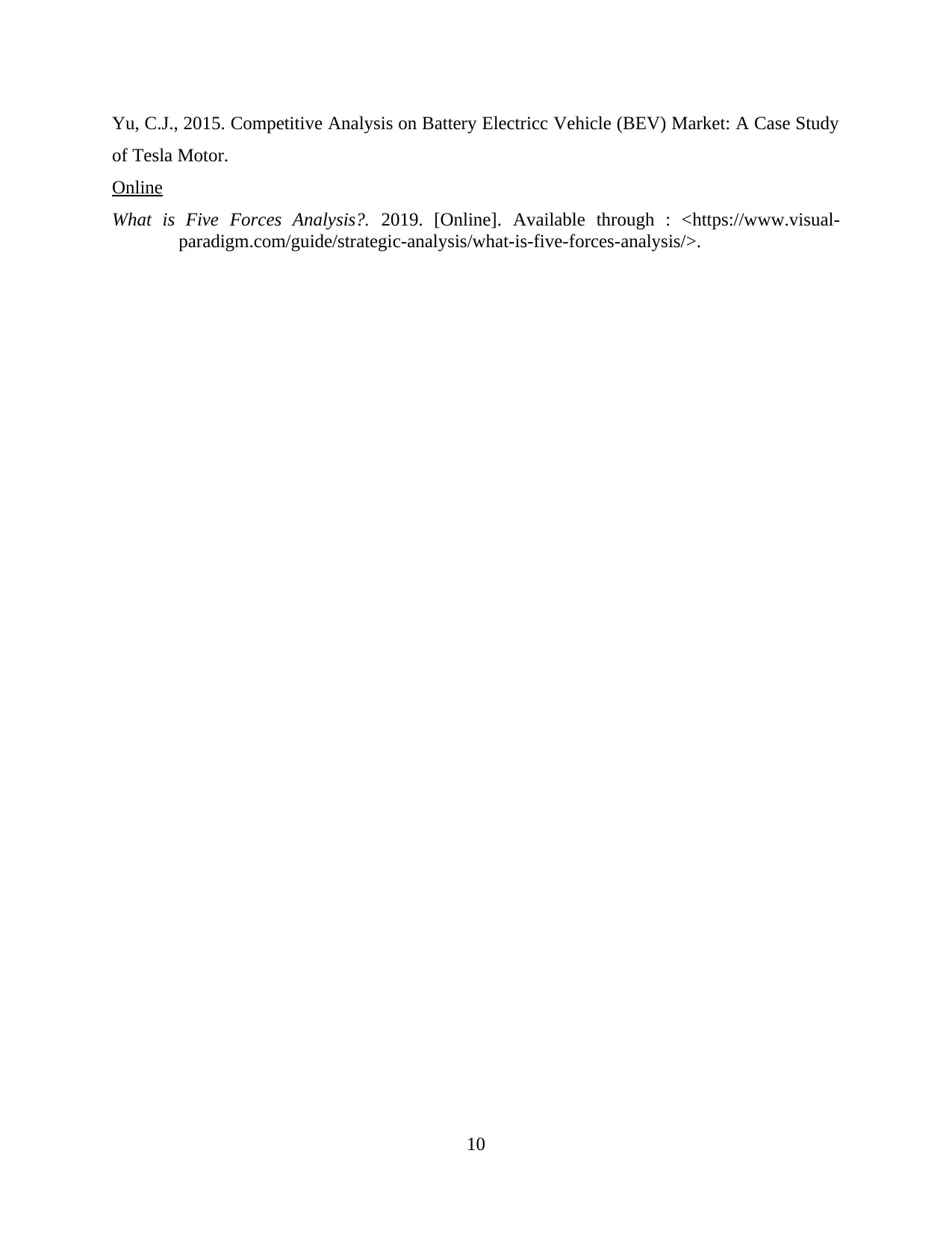
Yu, C.J., 2015. Competitive Analysis on Battery Electricc Vehicle (BEV) Market: A Case Study
of Tesla Motor.
Online
What is Five Forces Analysis?. 2019. [Online]. Available through : <https://www.visual-
paradigm.com/guide/strategic-analysis/what-is-five-forces-analysis/>.
10
of Tesla Motor.
Online
What is Five Forces Analysis?. 2019. [Online]. Available through : <https://www.visual-
paradigm.com/guide/strategic-analysis/what-is-five-forces-analysis/>.
10
⊘ This is a preview!⊘
Do you want full access?
Subscribe today to unlock all pages.

Trusted by 1+ million students worldwide
1 out of 12
Related Documents
Your All-in-One AI-Powered Toolkit for Academic Success.
+13062052269
info@desklib.com
Available 24*7 on WhatsApp / Email
![[object Object]](/_next/static/media/star-bottom.7253800d.svg)
Unlock your academic potential
Copyright © 2020–2025 A2Z Services. All Rights Reserved. Developed and managed by ZUCOL.





